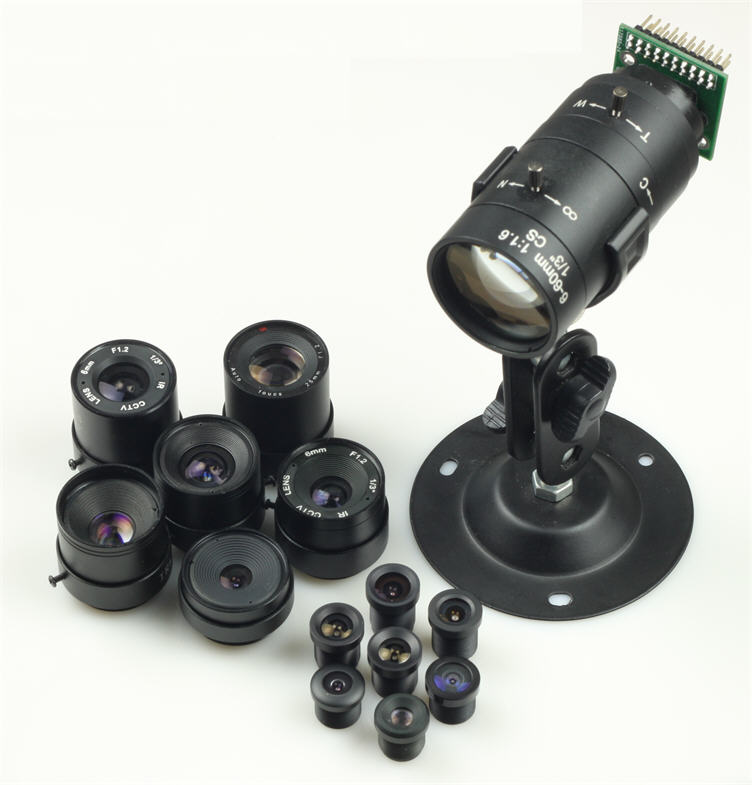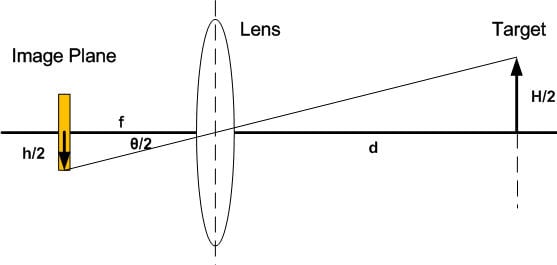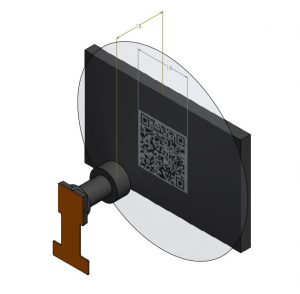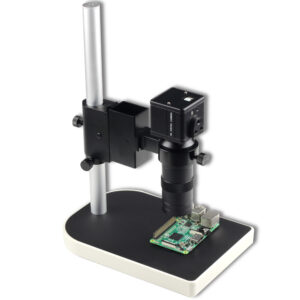Introduction¶
General Introduction¶
The lens is used to converge the light beams to an image plane on the image sensor for an clear and sharp frame, which is also an important part of the optical systems. Arducam has cultivated deeply into the optical systems and vision solution for decades. We have plenty of excellent Lens featured with many attributes for various kinds of the camera module.
Also, there are many resources for you to choose the appropriate Lens and camera combination.
-
To understand how to quickly sort out the best lens, refer to this Lens Selection Guide
-
To calculate the proper Field of View(FOV) of your project, please refer to Lens FOV Calculator
-
To figure out how to adjust the focus, please follow the link: How to adjust the lens focus
About the Lenses¶
Focal Length¶
Parallel incident light transmitted into a convex lens converges to a point on the optical axis. This point is the focal point of the lens. The distance between the principle point in the optical system and the focal point is referred to as the focal length. For a single thin lens, the focal length is equal to the distance between the center of the lens and the focal point.
Figure 1 Focal Length
Image Size and Lens Optical Format¶
A lens produces images in the form of a circle, called the image circle, also know as optical format. In a CCTV camera, the imaging element has a rectangular sensor area (the image size) that detects the image produced within the image circle. The ratio of the length of the horizontal to vertical sides of a video image is called the aspect ratio, which is normally 4:3 (H:V) for a standard CCTV camera.
Figure 2 Sensor Size
The lens optical format should match with target image sensor like the left most photo in the Figure3. If lens optical format and image size doesn’t match, it also works. But when the lens optical format is larger than image sensor, the lens FOV will be reduced; and when the lens optical format is smaller than image size there will be dark areas around the corners and some portion of the sensor area is not useful.
Figure 3 Image Circle
Minimum Object Distance¶
Minimum object distance (M.O.D.) indicates how close the lens can be placed to the object for shooting. It is measured from the vertex of the front glass of the lens. Sometimes, you can still focus the lens to very close object by manually focusing the lens. But you have to trade off between the close object and far away object, because only one can be well focused, the other end will be blurry. So the MOD parameter is specified for focusing on both close and far away object.
Back Focal Length¶
Distance between vertex of the rear element lens and image sensor. Sometimes the lens comes with very short focal length, so you should use proper lens holder to match the back focal length of the lenses. For example the fisheye lens LS-40180 can’t use any other lens holders except the mating lens holder designed specific for this lens.
Zoom Ratio¶
It is specific for zoom lenses rather than fix focus lens. Zoom ratio is the ratio of the focal length at the telephoto end to that at the wide end. A zoom lens can change the size of an object appearing on the monitor to the extent specified by the zoom ratio.
Field of View¶
The FOV is also called angle of view which is the shooting range that can be viewed by the lens given a specified image size. It is usually expressed in degrees. Normally the angle of view is measured assuming a lens is focused at infinity. The angle of view can be calculated if the focal length and image size are known.
Case Study¶
Figure 4 Lens case study
Given there is a QR code scanner application, we have a 1/4″ image sensor, and the camera is 15mm away from the QR code, the QR code size is 16mm x 16mm. How we will study how to calculate the lens FOV and select a proper lens for QR code scanner application.
If we want to use full image plane to capture the QR code, from the Figure 1 we can calculate the vertical FOV as 2 x arctan(H/2d). Where H is the height of the QR code and equals to 16mm. So the vertical FOV θ = 2 x arctan(16/2/15) = 56 degree.
Provide the image sensor aspect ratio is 4:3, we can calculate the horizontal FOV = 75 degree, and diagonal FOV = 94 degree. From the Figure 1 we can also calculate the focal length by the equation : f/d = h/H equals to f = d x (h/H). Now we can get f = 15 x (2.4/16) = 2.25mm.
Note that all the calculation is based on pinhole camera model, the real lens focus calculation is more complex the focal length will be different. The formula here just gives you a basic idea about the lens. You can choose the proper lens according to the FOV listed on the below table. And sometimes we might not need the QR code cover the entire image plane for the margin of scanning area, in this case we can choose larger FOV lens than we calculated above.
Some Available Lenses from ArduCAM¶
Low-Distortion Lenses¶
| Model NO. | Effective Focal Length | Optical Format | FOV(DxHxV) on 1/2.5'' Sensor | FOV(DxHxV) on 1/4'' Sensor |
|---|---|---|---|---|
| M2504ZH05S | 4mm | 1/2.5″ | 95°(D)x75°(H)x60°(V) | 95°(D)x75°(H)x60°(V) |
| M25360H065 | 3.6mm | 1/2.5″ | 120°(D)x90°(H)x75°(V) | 68°(D)x55°(H)x41°(V) |
| M27280M07S | 2.8mm | 1/2.7″ | 125°(D)x110°(H)x85°(V) | 92°(D)x74°(H)x55°(V) |
| M40210M09S | 2.1mm | 1/4'' | / | 110°(D)x93°(H)x70°(V) |
| M40320M06S | 3.2mm | 1/4'' | / | 85°(D)x64°(H)x51°(V) |
1/4'' Optical Format¶
| Model NO. | Effective Focal Length | Optical Format | HFOV(Degree) | VFOV(Degree) | DFOV(Degree) |
|---|---|---|---|---|---|
| LS-40136 | 3.2mm | 1/4″ | 70° | 63.7° | 85° |
| LS-40166 | 2.6mm | 1/4″ | 95° | 70° | 130° |
| LS-36021 | 2.8mm | 1/4″ | 96° | 72° | 120° |
| LS-1820 | 1.8mm | 1/4'' | 120° | 90° | 150° |
| LS-002 | 1.6mm | 1/4'' | 118° | 92° | 145° |
| LS-40180 | 1.05mm | 1/4'' | 194° | 142° | 204° |
1/3'' Optical Format¶
| Model NO. | Effective Focal Length | Optical Format | FOV(HxVxD) on 1/3'' Optical Size | FOV(HxVxD) on 1/4'' Optical Size |
|---|---|---|---|---|
| LS-1620 | 16mm | 1/3″ | 17.6°(H)x13.2°(V)x22°(D) | 13.2°(H)x9.9°(V)x16.5°(D) |
| LS-12020 | 12mm | 1/3″ | 20°(H)x15°(V)x25°(D) | 15°(H)x11.25°(V)x8.75°(D) |
| LS-8020 | 8mm | 1/3″ | 32°(H)x24°(V)x40°(D) | 24°(H)x18°(V)x30°(D) |
| LS-6020 | 6mm | 1/3″ | 48°(H)x36°(V)x60°(D) | 36°(H)x27°(V)x45°(D) |
| LS-30207 | 2.8mm | 1/3″ | 96°(H)x72°(V)x120°(D) | 72°(H)x54°(V)x90°(D) |
| LS-30208 | 2.8mm | 1/3″ | 100°(H)x75°(V)x125°(D) | 75°(H)x56.25°(V)x93.75°(D) |
| LS-0036 | 1.64mm | 1/3″ | 113°(H)x92°(V)x135°(D) | 81°(H)x60.75°(V)x101.25°(D) |
| LS-27225 | 2.1mm | 1/3″ | 124°(H)x70°(V)x145°(D) | 87°(H)x60.25°(V)x105.75°(D) |
| LS-30188 | 2.25mm | 1/3″ | 136°(H)x102°(V)x170°(D) | 102°(H)x76.5°(V)x127.5°(D) |
| LS-30180 | 1.58mm | 1/3″ | 185°(H)x138°(V)x230°(D) | 138°(H)x104°(V)x172°(D) |
| LS-30195 | 1.72mm | 1/3″ | 195°(H)x128°(V)x240°(D) | 144°(H)x108°(V)x180°(D) |
| LS-40146 | 1.52mm | 1/3.2″ | 191°(H)x127°(V)x204°(D) | 153°(H)x102°(V)x163°(D) |
| LS-32220 | 0.76mm | 1/3.2″ | 220°(H)x220°(V)x220°(D) | 220°(H)x220°(V)x220°(D) |
1/2.7'' Optical Format¶
| Model NO. | Effective Focal Length | Optical Format | FOV(HxVxD) on 1/2.7'' Optical Size | FOV(HxVxD) on 1/4'' Optical Size |
|---|---|---|---|---|
| LS-27227 | 4mm | 1/2.7″ | 84°(H)x63°(V)x105°(D) | 56°(H)x42°(V)x70°(D) |
| LS-0527 | 2.9mm | 1/2.7″ | 129°(H)x66°(V)x162°(D) | 87.48°(H)x65.61°(V)x109.35°(D) |
| LS-27180 | 1.3mm | 1/2.7″ | 185°(H)x185°(V)x185°(D) | 99.9°(H)x75°(V)x124.8°(D) |
1/2.5” Optical Format¶
| Model NO. | Effective Focal Length | Optical Format | FOV(HxVxD) on 1/2.5'' Optical Size | FOV(HxVxD) on 1/4'' Optical Size |
|---|---|---|---|---|
| LS-20211 | 3.8mm | 1/2.5″ | 85°(H)x76°(V)x101°(D) | 50.4°(H)x37.8°(V)x63°(D) |
| LS-4014 | 3mm | 1/2.5″ | 112°(H)x84°(V)x140°(D) | 70°(H)x52.5°(V)x87.5°(D) |
| LS-20150 | 2.8mm | 1/2.5″ | 110°(H)x80°(V)x160°(D) | 80°(H)x60°(V)x100°(D) |
| LS-25180 | 1.6mm | 1/2.5″ | 185°(H)x185°(V)x185°(D) | 140°(H)x105°(V)x175°(D) |
1/2.3” Optical Format¶
| Model NO. | Effective Focal Length | Optical Format | FOV(HxVxD) on 1/2.3'' Optical Size | FOV(HxVxD) on 1/4'' Optical Size |
|---|---|---|---|---|
| LS-81600 | 2.8mm | 1/2.3″ | 120°(H)x95°(V)x155°(D) | 71.2°(H)x53.4°(V)x89°(D) |
| LS-20150238 | 2.8mm | 1/2.3″ | 118°(H)x88.5°(V)x150°(D) | 68.8°(H)x51.6°(V)x86°(D) |
| LS-18023 | 4.2mm | 1/1.8″ | 112°(H)x84°(V)x140°(D) | 50.4°(H)x37.8°(V)x63°(D) |
| MTV2520B | 25mm | 1/2″ | 15.2°(H)x11.4°(V)x19°(D) | 7.6°(H)x5.7°(V)x9.5°(D) |
Microscope Lens¶
AR55100 CS mount microscope lens





